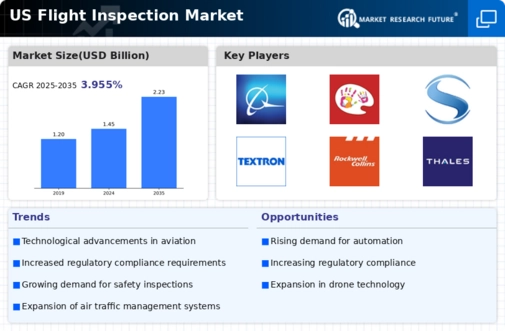The US Flight Inspection Market is a niche segment within the broader aerospace and defense industry, focusing on ensuring the accuracy and reliability of aviation navigation systems. This market plays a critical role in maintaining safety standards for air traffic, as various government agencies and private sector entities rely on flight inspection services to validate the performance of their navigation aids, including Instrument Landing Systems (ILS) and GPS equipment. The competitive landscape is characterized by a mix of established defense contractors and specialized service providers, each vying for contracts with federal and state aviation authorities.
The demand for flight inspection services is anticipated to remain robust, driven by an increase in air traffic, advancements in technology, and the need for ongoing compliance with regulatory requirements. Companies are differentiating themselves through innovative solutions, such as advanced inspection equipment and data analytics, aiming to optimize flight inspection processes and improve efficiency.Raytheon Technologies stands as a formidable player in the US Flight Inspection Market, leveraging its advanced technological capabilities and extensive experience in aeronautics. The company has a significant presence in various aspects of flight inspection, particularly through its defense and aerospace divisions.
Raytheon Technologies is known for its investment in research and development, which enables them to modernize flight inspection techniques and equipment. Their strengths lie in their established relationships with various government agencies and a reputation for reliability and accuracy in their services. The company's access to a diverse portfolio of advanced aerospace technology allows it to provide enhanced flight inspection solutions that meet or exceed regulatory standards.
Moreover, Raytheon Technologies has successfully forged partnerships that bolster their market position, enabling them to maintain competitive advantages in efficiency and innovation in flight inspection operations.Airbus, a key player in the US Flight Inspection Market, offers a wide range of services and products aimed at supporting and enhancing the safety and efficiency of flight operations.
The company has developed a strong foothold in flight inspection services, focusing on providing cutting-edge solutions such as Unmanned Aerial Vehicles (UAVs) and advanced flight inspection systems. Airbus's strengths include a solid reputation for engineering excellence and a commitment to integrating next-generation technologies within their flight inspection offerings. In recent years, Airbus has expanded its market presence through strategic mergers and acquisitions, allowing it to acquire innovative technologies and skilled workforce capabilities. This expansion has enabled Airbus to provide comprehensive services tailored to meet the specific needs of the US aviation sector.
Their focus on continuous improvement and customer-centric solutions further solidifies their position as a key competitor in the US Flight Inspection Market.




















